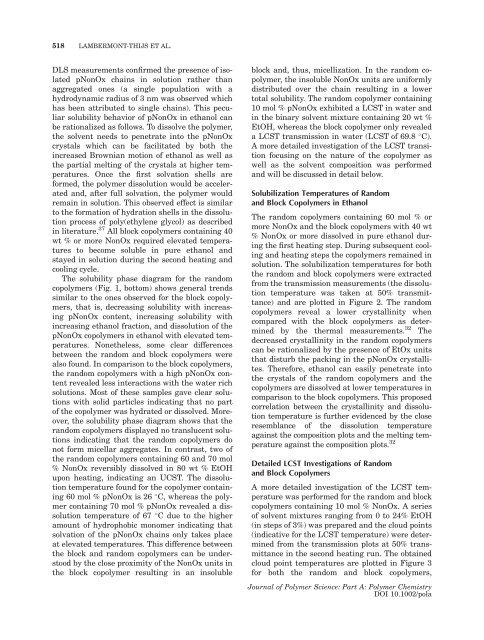Solubility behavior of amphiphilic block and random copolymers ...
Solubility behavior of amphiphilic block and random copolymers ...
Solubility behavior of amphiphilic block and random copolymers ...
You also want an ePaper? Increase the reach of your titles
YUMPU automatically turns print PDFs into web optimized ePapers that Google loves.
518 LAMBERMONT-THIJS ET AL.<br />
DLS measurements confirmed the presence <strong>of</strong> isolated<br />
pNonOx chains in solution rather than<br />
aggregated ones (a single population with a<br />
hydrodynamic radius <strong>of</strong> 3 nm was observed which<br />
hasbeenattributedtosinglechains).Thispeculiar<br />
solubility <strong>behavior</strong> <strong>of</strong> pNonOx in ethanol can<br />
be rationalized as follows. To dissolve the polymer,<br />
the solvent needs to penetrate into the pNonOx<br />
crystals which can be facilitated by both the<br />
increased Brownian motion <strong>of</strong> ethanol as well as<br />
the partial melting <strong>of</strong> the crystals at higher temperatures.<br />
Once the first solvation shells are<br />
formed, the polymer dissolution would be accelerated<br />
<strong>and</strong>, after full solvation, the polymer would<br />
remain in solution. This observed effect is similar<br />
to the formation <strong>of</strong> hydration shells in the dissolution<br />
process <strong>of</strong> poly(ethylene glycol) as described<br />
in literature. 37 All <strong>block</strong> <strong>copolymers</strong> containing 40<br />
wt % or more NonOx required elevated temperatures<br />
to become soluble in pure ethanol <strong>and</strong><br />
stayed in solution during the second heating <strong>and</strong><br />
cooling cycle.<br />
The solubility phase diagram for the r<strong>and</strong>om<br />
<strong>copolymers</strong> (Fig. 1, bottom) shows general trends<br />
similar to the ones observed for the <strong>block</strong> <strong>copolymers</strong>,<br />
that is, decreasing solubility with increasing<br />
pNonOx content, increasing solubility with<br />
increasing ethanol fraction, <strong>and</strong> dissolution <strong>of</strong> the<br />
pNonOx <strong>copolymers</strong> in ethanol with elevated temperatures.<br />
Nonetheless, some clear differences<br />
between the r<strong>and</strong>om <strong>and</strong> <strong>block</strong> <strong>copolymers</strong> were<br />
also found. In comparison to the <strong>block</strong> <strong>copolymers</strong>,<br />
the r<strong>and</strong>om <strong>copolymers</strong> with a high pNonOx content<br />
revealed less interactions with the water rich<br />
solutions. Most <strong>of</strong> these samples gave clear solutions<br />
with solid particles indicating that no part<br />
<strong>of</strong> the copolymer was hydrated or dissolved. Moreover,<br />
the solubility phase diagram shows that the<br />
r<strong>and</strong>om <strong>copolymers</strong> displayed no translucent solutions<br />
indicating that the r<strong>and</strong>om <strong>copolymers</strong> do<br />
not form micellar aggregates. In contrast, two <strong>of</strong><br />
the r<strong>and</strong>om <strong>copolymers</strong> containing 60 <strong>and</strong> 70 mol<br />
% NonOx reversibly dissolved in 80 wt % EtOH<br />
upon heating, indicating an UCST. The dissolution<br />
temperature found for the copolymer containing<br />
60 mol % pNonOx is 26 C, whereas the polymer<br />
containing 70 mol % pNonOx revealed a dissolution<br />
temperature <strong>of</strong> 67 C due to the higher<br />
amount <strong>of</strong> hydrophobic monomer indicating that<br />
solvation <strong>of</strong> the pNonOx chains only takes place<br />
at elevated temperatures. This difference between<br />
the <strong>block</strong> <strong>and</strong> r<strong>and</strong>om <strong>copolymers</strong> can be understood<br />
by the close proximity <strong>of</strong> the NonOx units in<br />
the <strong>block</strong> copolymer resulting in an insoluble<br />
<strong>block</strong> <strong>and</strong>, thus, micellization. In the r<strong>and</strong>om copolymer,<br />
the insoluble NonOx units are uniformly<br />
distributed over the chain resulting in a lower<br />
total solubility. The r<strong>and</strong>om copolymer containing<br />
10 mol % pNonOx exhibited a LCST in water <strong>and</strong><br />
in the binary solvent mixture containing 20 wt %<br />
EtOH, whereas the <strong>block</strong> copolymer only revealed<br />
a LCST transmission in water (LCST <strong>of</strong> 69.8 C).<br />
A more detailed investigation <strong>of</strong> the LCST transition<br />
focusing on the nature <strong>of</strong> the copolymer as<br />
well as the solvent composition was performed<br />
<strong>and</strong> will be discussed in detail below.<br />
Solubilization Temperatures <strong>of</strong> R<strong>and</strong>om<br />
<strong>and</strong> Block Copolymers in Ethanol<br />
The r<strong>and</strong>om <strong>copolymers</strong> containing 60 mol % or<br />
more NonOx <strong>and</strong> the <strong>block</strong> <strong>copolymers</strong> with 40 wt<br />
% NonOx or more dissolved in pure ethanol during<br />
the first heating step. During subsequent cooling<br />
<strong>and</strong> heating steps the <strong>copolymers</strong> remained in<br />
solution. The solubilization temperatures for both<br />
the r<strong>and</strong>om <strong>and</strong> <strong>block</strong> <strong>copolymers</strong> were extracted<br />
from the transmission measurements (the dissolution<br />
temperature was taken at 50% transmittance)<br />
<strong>and</strong> are plotted in Figure 2. The r<strong>and</strong>om<br />
<strong>copolymers</strong> reveal a lower crystallinity when<br />
compared with the <strong>block</strong> <strong>copolymers</strong> as determined<br />
by the thermal measurements. 32 The<br />
decreased crystallinity in the r<strong>and</strong>om <strong>copolymers</strong><br />
can be rationalized by the presence <strong>of</strong> EtOx units<br />
that disturb the packing in the pNonOx crystallites.<br />
Therefore, ethanol can easily penetrate into<br />
the crystals <strong>of</strong> the r<strong>and</strong>om <strong>copolymers</strong> <strong>and</strong> the<br />
<strong>copolymers</strong> are dissolved at lower temperatures in<br />
comparison to the <strong>block</strong> <strong>copolymers</strong>. This proposed<br />
correlation between the crystallinity <strong>and</strong> dissolution<br />
temperature is further evidenced by the close<br />
resemblance <strong>of</strong> the dissolution temperature<br />
against the composition plots <strong>and</strong> the melting temperature<br />
against the composition plots. 32<br />
Detailed LCST Investigations <strong>of</strong> R<strong>and</strong>om<br />
<strong>and</strong> Block Copolymers<br />
A more detailed investigation <strong>of</strong> the LCST temperature<br />
was performed for the r<strong>and</strong>om <strong>and</strong> <strong>block</strong><br />
<strong>copolymers</strong> containing 10 mol % NonOx. A series<br />
<strong>of</strong> solvent mixtures ranging from 0 to 24% EtOH<br />
(in steps <strong>of</strong> 3%) was prepared <strong>and</strong> the cloud points<br />
(indicative for the LCST temperature) were determined<br />
from the transmission plots at 50% transmittance<br />
in the second heating run. The obtained<br />
cloud point temperatures are plotted in Figure 3<br />
for both the r<strong>and</strong>om <strong>and</strong> <strong>block</strong> <strong>copolymers</strong>,<br />
Journal <strong>of</strong> Polymer Science: Part A: Polymer Chemistry<br />
DOI 10.1002/pola
















